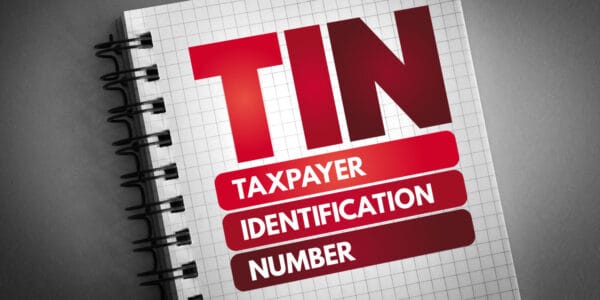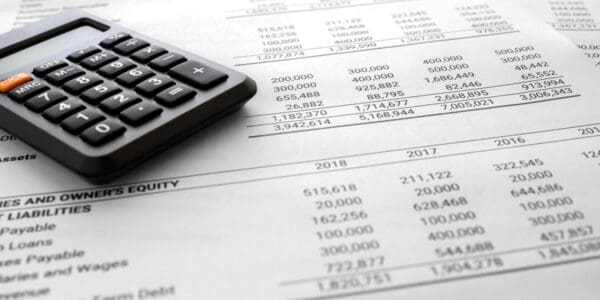If you’re the director or shareholder of a limited company, you may have heard of Tax Identification Numbers, often referred to as TINs. Perhaps you recently registered your company and are eagerly awaiting your TIN.
In this post, we cover everything you need to know about the TIN, including why – as a company director and/or shareholder – you’re wasting your time if you are waiting to receive a ‘TIN’ (and what you should be keeping an eye out for instead). Let’s get started.
What is a Tax Identification Number (TIN)?
A TIN is a unique tax identifier, typically made up of letters and numbers, that’s assigned to an account holder by their specific tax jurisdiction. TIN is not a term that’s common in the United Kingdom; however, it is popular across the EU and in America. Because of this, if a UK limited company is working with a business based in the EU or America, it is not uncommon for the UK company to be asked to present a TIN.
The purpose of the TIN is to identify a taxpayer and, in turn, help facilitate the administration of tax affairs (both national and cross-border).
HM Revenue & Customs (HMRC) – the UK government body responsible for the collection of taxes, does not issue anything that’s referred to as a TIN. Nor do Companies House, the UK’s official registrar of companies.
Nonetheless, because of the ambiguity surrounding the term, there are some unique identifiers that could be described as the UK’s alternatives to TINs.
TINs for a UK limited company and its directors
If you have been asked to present a TIN, it’s likely that the person/organisation making the request actually wants one of the below:
Company registration number (CRN)
The company registration number (sometimes referred to as the company number) is a unique eight-character string that is automatically given to a company as soon as it is registered at Companies House.
This number should be published on the company’s website, stationery, and any other official company documentation, such as invoices.
By presenting a company number, a business is demonstrating that they are a registered company at Companies House.
Despite its name, the company registration number does not always consist of just numbers. The format depends on the company type (is it limited by shares, a limited liability partnership or a limited partnership?) and jurisdiction (was it formed in England & Wales, Scotland, or Northern Ireland?).
Examples of the different company registration numbers
| Company type | Jurisdiction | Example |
| Limited by shares | England & Wales or only Wales | 01234567 |
| Scotland | SC123456 | |
| Northern Ireland | NI123456 | |
| Limited liability partnership | England & Wales or only Wales | OC123456 |
| Scotland | SO123456 | |
| Northern Ireland | NC123456 | |
| Limited partnership | England & Wales or only Wales | LP123456 |
| Scotland | SL123456 | |
| Northern Ireland | NL123456 |
Your company registration number can be found in a number of places, including:
- Your Client Portal, if you are a Quality Company Formations customer. Once you have logged in, select ‘My Companies’, you will then see the ‘Number’.
- The Companies House register. All you need to do is search for the company, and you will then see the number.
- On the Certificate of Incorporation. This will have been issued when your company was registered.
Employer Reference Number (ERN)
The Employer Reference Number (also known as the ERN or PAYE reference number) is issued by HMRC when you register your business as an employer. You need this number when dealing with anything related to employment.
The ERN will follow this format: 123/AA1234.
If you have registered as an employer, you will find the ERN in your HMRC welcome pack (sent upon registration), any correspondence that you have had with HMRC related to PAYE, payslips that you have provided to employees, and any P60s and P45s.
National Insurance Number (NI)
When a UK resident reaches the age of 16, they are automatically issued with a National Insurance number.
This unique number is used to ensure that National Insurance contributions and tax contributions are recorded against that person only. Whilst an individual will need to provide their NI number in a number of different scenarios, as a company director specifically, you will need your NI number if you are paying yourself through PAYE.
The NI number comprises of 2 letters, 6 numbers, and a final letter. For example, AB123456D.
You will be able to find your NI number on your payslips, your P60, and letters relating to tax, insurance, or benefits. If you can’t locate any of these documents, you should complete the CA5403 form or call 0300 200 3500.
Unique Taxpayer Reference (UTR)
The Unique Taxpayer Reference (also known as the UTR or sometimes Tax Reference) is a unique 10-digit number that is automatically assigned by HMRC when a company is formed (and when an individual registers for Self Assessment). The UTR helps a business identify itself when dealing with issues related to tax, and should be used in any correspondence with HMRC.
The UTR is typically shown in this format: 12345 67890.
Your UTR will be mailed to the company’s registered office address within 3 weeks of your company being formed. You will then find it in any future correspondence sent from HMRC.
If you have misplaced the UTR and can’t locate any previous mail from HMRC, you can get a copy of the UTR re-sent to your registered office. All you need to provide is your company registration number and company name.
VAT registration number
If you register your business for VAT, HMRC will send you a unique 9-digit VAT registration number (or VAT number). This number helps identify a business in matters related to VAT.
As a VAT-registered business, you should include your VAT registration number on your website, invoices, and any receipts that you may issue.
A VAT number for a business located in England, Scotland, or Wales will follow this format: GB123456789. A VAT number for a business located in Northern Ireland will look like this: XI123456789.
The VAT number is sent out by HMRC upon successful registration (this takes approximately 20 days). If you have lost track of the number and you can’t find the initial HMRC registration documents (and you haven’t yet published the number on your website or any invoices), we recommend contacting HMRC directly.
Keeping your TINs safe
Some of the unique identifiers we have highlighted in this post should only be passed on to trusted individuals/bodies.
Whilst the company registration and VAT registration numbers need to be made public, we strongly recommend keeping all of the other identifiers private (Employer Reference Number, National Insurance Number, Unique Taxpayer Reference) unless you are certain that the individual/organisation making the request is doing so for the right reasons.
If in doubt, feel free to comment on this blog and we’ll advise you accordingly.
Are you a Quality Company Formations customer with an address service?
If you have a Registered Office Address Service and/or Director’s Service Address with us, we will accept mail from official government bodies including HMRC and Companies House. This mail is securely opened, scanned, and then emailed to you.
These scans are also securely stored in your Client Portal.
This means, if you have misplaced any of the TINs covered in this post, you may find these in your account. To check – Log in, select ‘My Mail’ and then click on the PDF icon(s).
Thanks for reading
Tax Identification Numbers or TINs may not be common terminology in the UK; however, they are widely used elsewhere, and are an integral part of doing business on a global scale. As such, it makes good business sense to have an understanding of what someone may mean when they refer to a TIN. We hope this post has helped you in grasping this.
Please leave a comment if you have any questions.
Please note that the information provided in this article is for general informational purposes only and does not constitute legal, tax, or professional advice. While our aim is that the content is accurate and up to date, it should not be relied upon as a substitute for tailored advice from qualified professionals. We strongly recommend that you seek independent legal and tax advice specific to your circumstances before acting on any information contained in this article. We accept no responsibility or liability for any loss or damage that may result from your reliance on the information provided in this article. Use of the information contained in this article is entirely at your own risk.












Join The Discussion